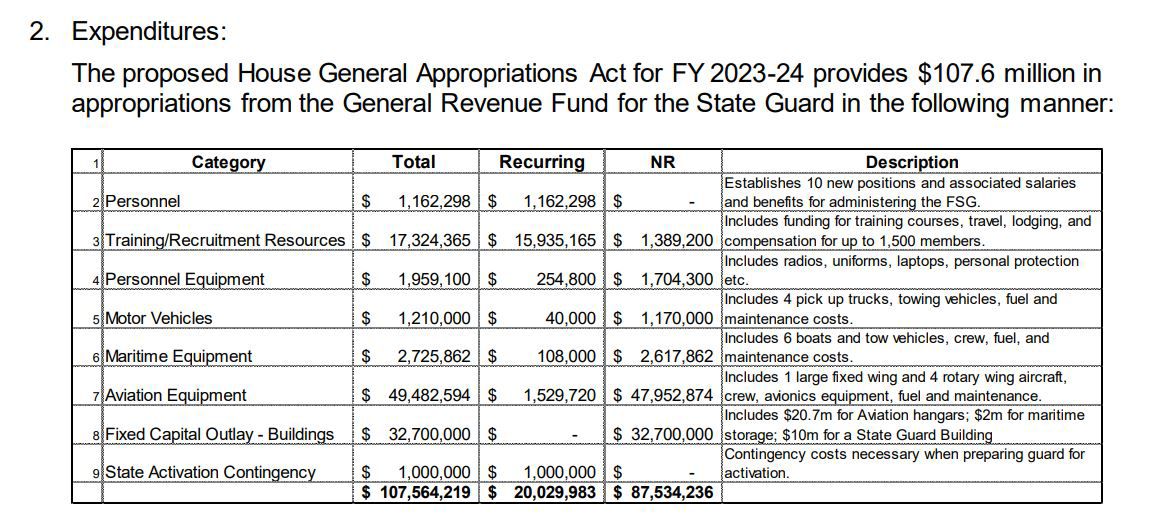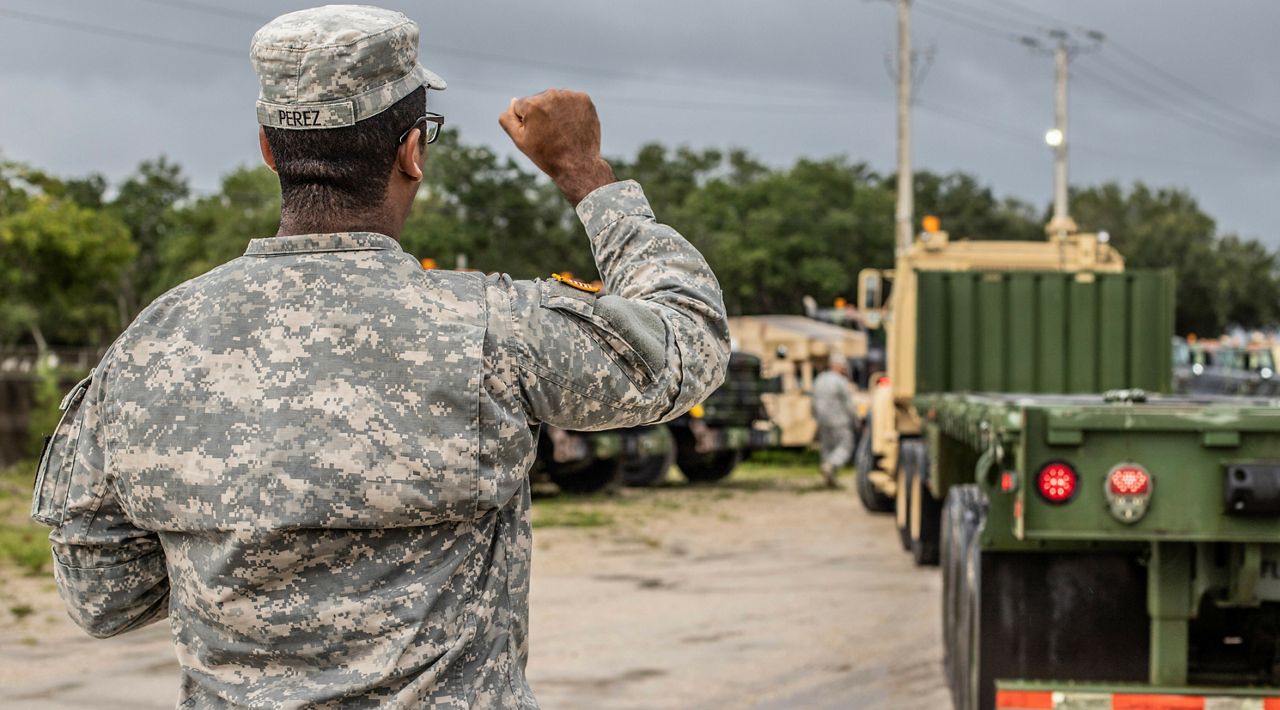A bill that would reauthorize the Florida State Guard, nearly triple its current 400 member capacity and greatly expand its funding for equipment was sent to the desk of Florida Gov. Ron DeSantis on Monday.
What You Need To Know
- A bill to reauthorize the Florida State Guard was sent to Gov. Ron DeSantis on Monday
- The new proposal will increase the allowed volunteers from 400 to 1,500
- It will also allow members of the guard to help local police
- There are 22 states with an active state guard
The Florida State Guard was brought back into existence during last year’s legislative session, but it had an expiration date written in the law of July 1, 2023. Under that law, the guard had an allowed member capacity of 400, but the bill on the governor's desk will increase that to 1,500 volunteers.
The FSG’s authorization comes from the same federal rule that allows for the Florida National Guard, according to an analysis of the bill published by the House Appropriations Committee.
“Federal law authorizes each state, the Commonwealth of Puerto Rico, the District of Columbia, Guam, and the Virgin Islands to create and maintain organized units other than their respective National Guard units,” the analysis states.
“These separate units, called ‘defense forces,’ are for use exclusively within the jurisdiction as considered necessary by the Governor or chief executive of such jurisdiction but may not be called, ordered, or drafted into federal service,” it continued.
The new bill, CS/HB 1285, will make the guard a new permanent component of the state militia, alongside the National Guard.
This new branch will be led by a director who will be appointed by the governor and confirmed by the Senate. The governor will have final control and command of the state guard.
According to the legislation, the Florida State Guard and its volunteers may be activated for the following reasons:
- During any period when any part of the Florida National Guard is in active federal service and the governor has declared a state of emergency
- To preserve the public peace, execute the laws of the state, enhance domestic security, respond to terrorist threats or attacks, respond to an emergency or imminent danger thereof, or respond to any need for emergency aid to civil authorities
One aspect of the proposal drawing scrutiny calls for a specialized unit of volunteers within the greater FSG that would allow them to carry weapons and act with the same legal authority of any law enforcement agency they are working with.
Democrats argue that the new arm of the state militia could be used to carry out a political agenda, according to a letter sent by U.S. Rep. Glenn Ivey of Maryland, asking the House Judiciary Committee to investigate the move.
“The Governor has proposed tripling the size of the Florida State Guard to 1,500 and grow its budget to $100 million," Ivey said in the letter. "The recently revived force would carry weapons, make arrests, and may even monitor ballot boxes, track illegal immigrants, and respond to protests at the direction of the governor."
“We cannot be good stewards of taxpayer dollars by funding a law enforcement arm that is being weaponized for a single governor’s personal political purposes. Whether it is seeking to disenfranchise voters, violate civil liberties, or dig up political dirt, the FDLE under Governor DeSantis’ direction requires oversight by this Committee,” the letter concludes.
I am calling on @Jim_Jordan & @JudiciaryGOP to immediately open an investigation into @GovRonDeSantis and his alleged mishandling of federally funded police in Florida to carry out his political agenda, intimidate voters, and abuse his authority. Americans deserve transparency. pic.twitter.com/5AOWCe0IWy
— Rep. Glenn Ivey (@RepGlennIvey) May 17, 2023
When DeSantis first proposed the new guard in late 2021, he argued there was a need for qualified volunteers to help the National Guard during emergencies.
"It’s the federal government plucking our good national guardsmen and sending them around the world and so, we only have a limited capacity at that point," DeSantis said at the time. "So, we thought it would be important to expand that and the easiest way to expand it was to restart something that we had in our state for a long time, our own Florida State Guard.”
Democrats like former Florida Gov. Charlie Crist challenged the move, tweeting that “no Governor should have his own handpicked secret police.”
DeSantis laid out his plan for the guard when he proposed the force.
“Reestablishing the Florida State Guard will allow civilians from all over the state to be trained in the best emergency response techniques and have the ability to mobilize very, very quickly,” he said in Pensacola.
He also said that the new Florida State Guard was essential because the federal government hadn't increased the maximum number of members allowed in the Florida National Guard in decades.
According to bill sponsor Rep. Bryan Avila of Dade County, the state ranks number 53 of 54 states and territories when it comes to numbers of National Guard members compared to state size.
Avila also tried to assuage concerns about the guard's police capacity.
“The specialized unit within the State Guard would be sort of an MP, law enforcement type of entity," he said in a Senate Appropriations Committee meeting last month. "Again, this is in certain times where natural disasters are where you need to stabilize the situation. You need to have a force to augment any local capabilities, rather it’s a sheriff’s office or police department."
The new bill will allow for $107 million in spending, most of which will go toward funding one large fixed-wing and four rotary-wing aircraft, along with crew, fuel and maintenance.
The rest of the spending goes toward training and recruitment, equipment like uniforms and laptops, four pickup tricks, six boats, and $32 million for buildings like aviation hangars, maritime storage, and a state guard building, according to the analysis.

The breakdown of expenditures allowed in the law, according to the Florida House Committee on Appropriations.
An amendment to the proposal approved on March 14 replaced all military language when referring to personnel in favor of the word “volunteers,” among other staffing changes.
The Florida State Defense Force, the progenitor of the Florida State Guard, was created in 1941 to supplement the state’s National Guard, which was emptied as members of the guard were called into service during World War II.
The force was deactivated and disbanded in 1947 shortly after members of the Florida National Guard returned from service.
The state of Texas has a state guard that was used by Gov. Greg Abbott to monitor federal military exercises in his state in 2015. There are currently 22 states that have an active state guard force.



